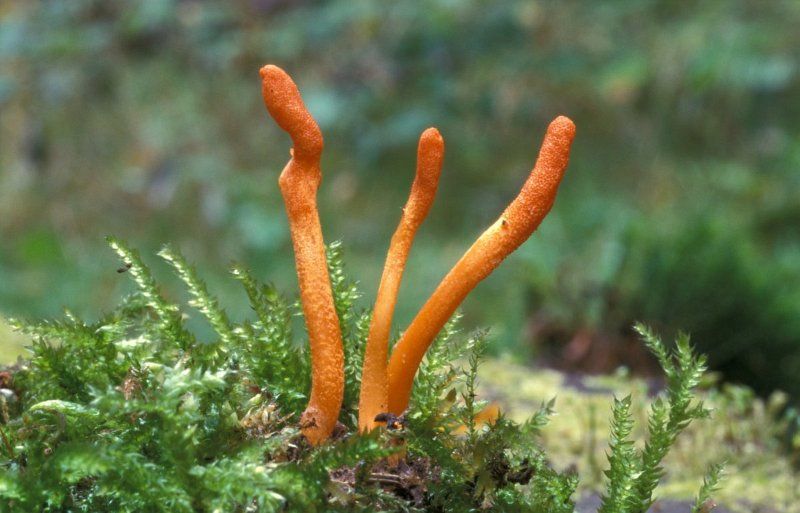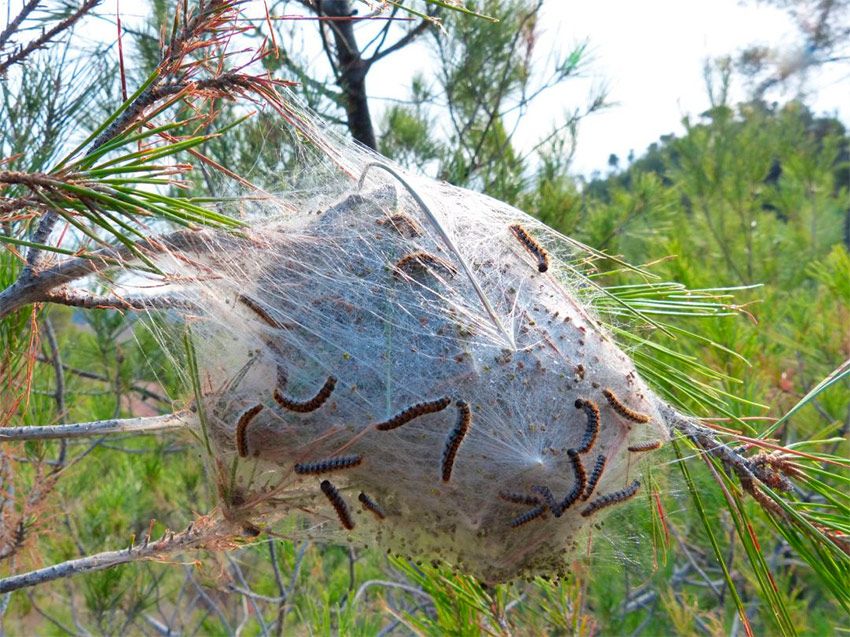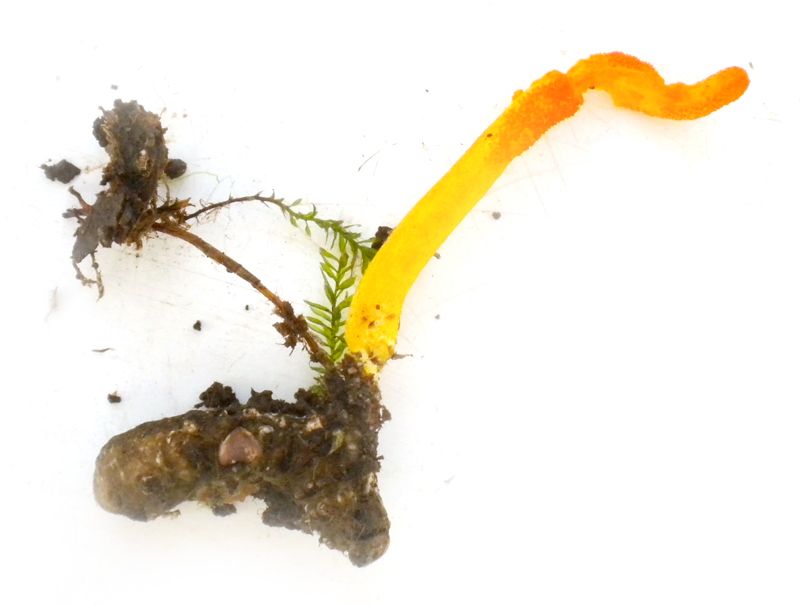Cordyceps militaris: the solution to processionary disease
7 years ago · Updated 6 months ago

Cordyceps militaris: a natural ally against the processionary caterpillar
Cordyceps militaris is a small orange-colored mushroom that, at first glance, could be mistaken for a Clavaria due to its elongated shape and bright color. However, this mushroom has a fascinating feature: it does not feed on wood or plant debris, but parasitizes insects. In particular, it can be a biological solution for controlling the pine processionary caterpillar, Thaumetopoea pityocampa, which seriously affects pine forests in our region.
Instead of sprouting from the ground or wood, Cordyceps militaris grows directly from the parasitized larvae or pupae of these caterpillars. These tiny fungi emerge from the insect's body once the fungus has completed its internal development, causing the host's death in the process. Their small size and inconspicuous shape mean that they often go unnoticed in the forest.
Like all fungi, Cordyceps militaris reproduces by means of spores that are carried by the wind. These spores can remain attached to the silky nests of the processionary caterpillar or between the fine stinging hairs of the caterpillars themselves. They remain there until, in their natural cycle, the caterpillars descend to the ground to burrow into the soil and transform into chrysalids, at which point the fungus takes advantage of this to colonize them.
The pine processionary caterpillar voraciously feeds on the young shoots of pine trees, compromising their health and growth. Faced with this threat, Cordyceps militaris appears to be a promising ecological alternative for the biological control of this pest, reducing its impact without resorting to aggressive chemical treatments.

Cordyceps militaris: the fungus that attacks insects
Cordyceps militaris is an entomopathogenic fungus, meaning it is a fungus that parasitizes insects. Its cycle begins when its spores come into contact with a suitable host. When they encounter optimal humidity and temperature conditions, the spores germinate and the fungus invades the insect's body, feeding on it from the inside until it kills it.
After eliminating the host, Cordyceps continues its development by forming orange-colored carpophores, small reproductive structures that emerge from the insect's body. From there, it will reseed spores to infect new organisms. This process is common to many species of the genus Cordyceps, each specializing in a specific insect. In some cases, these fungi even manage to alter the behavior of the parasitized insect to promote their spread.
A closely related species, Cordyceps sinensis, is highly prized in traditional Asian medicine for its supposed revitalizing and immunostimulating properties, and has been used for centuries as a natural supplement.
Cordyceps militaris and the pine processionary caterpillar
In spring, it is common to see pine forests where the trees appear devoid of their green foliage and dry in appearance. Hanging from their branches are large white masses that are the nests of Thaumetopoea pityocampa, commonly known as the pine processionary caterpillar. This caterpillar is an increasingly widespread pest, responsible for the defoliation of large areas of pine forest.
One of the peculiarities of this species of caterpillar is the way it moves: it moves in a line, one behind the other, which has earned it the name “processionary.” These “processions” can be made up of dozens or even hundreds of individuals.
In recent years, Cordyceps militaris has attracted interest as a potential biological control agent against this pest. By infecting the larvae and pupae of the processionary caterpillar, it can help to naturally reduce their population without the use of chemical pesticides. Its use, which is still being studied, paves the way for more sustainable strategies in the fight against this caterpillar, which is so harmful to forest ecosystems.

Processionaria: dangerous for pets
These insects are covered with highly urticating hairs. They can disperse and detach them if disturbed, causing irritation to the skin and mucous membranes. They can even cause allergies that can have very serious consequences.
These caterpillars weave a bag-like nest where they spend the day among the pine needles they feed on. The nests are made up of a multitude of very strong silk filaments that are also fire-resistant.
When they go in search of food, the small pine buds use a fine silk thread as a guide to return to the nest. This guide thread ensures that they return in procession.
Spring arrives and the processionary caterpillars emerge
In early spring, when they are already adults, they descend to the ground and burrow into it to continue their cycle. And then the spores of Cordyceps militaris spring into action.
These small mushrooms are club-shaped. They are small, between 2 and 6 cm high. They feed on the larvae and emerge from the ground like small bright yellow-orange flames. Each one has colonized the larva of a processionary caterpillar that will never reproduce.
This fungus is not a definitive solution to this scourge. But it demonstrates the benefits that fungi bring to forest life.
Cordyceps militaris against the processionary caterpillar
This small fungus from the Cordyceps family, which grows in our pine forests, may be the solution to the pine processionary caterpillar plague, as a recent study has shown. We explain it in detail below.

A recent study carried out at the Chair of Mycology at the Higher Technical School of Agricultural Engineering at the La Yutera Campus (Palencia) has shown that it is possible to control the processionary caterpillar pest.
The proliferation of pine processionary caterpillar populations (Thaumetopea pityocampa) has been enormous. The affected area has continued to grow. Added to this are rising temperatures and lack of rain. Currently, processionary caterpillars can be found in most of our forests, even reaching areas where they had never been seen before.
Many voices are calling for measures to be taken before the damage caused is irreparable. The damage caused by these insects is extensive, both economically and in terms of allergies and health.
Absence of natural predators of the processionary caterpillar
The difficulty in eradicating these insects lies in the fact that they have no known natural predators. And the few that do exist are unable to reproduce at a rate that keeps pace with the increase in the pest population. However, thanks to this study, it seems that things are about to change.

According to comments by J. A. Oria de Rueda, director of the mycology department, this new system has already been tested in certain plots in Castile and León, where the effectiveness of this eco-insecticide has been demonstrated.
After using Cordyceps militaris fungi on caterpillars that had already burrowed underground, 80-100% of them were eliminated. This level of effectiveness even surprised the authors of the study.

Cordyceps militaris: a native fungus
The cordyceps militaris fungus grows naturally in our mountains, so it would be enough to select the strains that are most aggressive to insects. In this way, it would be possible to reproduce the fungus on a large scale for application over large areas.
The spores of this fungus would be applied by spraying them dissolved in a liquid. This treatment would be completely natural and free of insecticides or aggressive chemicals. The spores adhere to the caterpillars' stinging hairs. Later, they fruit and completely colonize the insect's body.
Among the strains of Cordyceps militaris, those from Mediterranean areas have proven to be the most effective in eliminating caterpillars.

We will see if we can finally put an end to this scourge. It is necessary to find it because of the many problems it causes to people, animals, and pets.
Health and cordyceps militaris!

Te pueden interesar